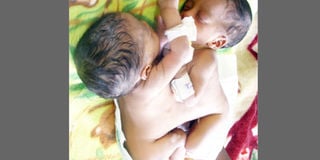Conjoined twin births: How they come about

The Kabale twins: Rosette Tusiime and Dennis Owomugisha’s conjoined twins soon after they were born last year on June 10. They were successfully separted in Cairo, Egypt. FILE Photo
Siamese twins should be identical twins, but something goes wrong during early development in the womb so that they do not completely separate, wirtes, Sarah Tumwebaze.
Throughout the nine months of pregnancy, Rosette Tusiime, a small scale business woman thought she was carrying one baby. So did the nurses that were catering to her during anti-natal. She explains that she did not go for a scan because of the fear that she might find out that she was carrying a girl and yet she wanted a boy.
However, on June 13, 2011, shortly after the caesarian section, when the doctors announced to the half-awake mother that she had two boys, she was filled with joy. “But as the doctors carried out the twins from my womb, I noticed that they were joined. I was in shock.” Tusiime intimated while breast feeding her twins at Mulago hospital, last year.
In Uganda, conjoined or Siamese twins were rarely heard of. Apart from a pair that was born over 15 years ago, we had since not heard of such twins in Uganda until last year in June and then this year still in June.
According to Dr Henry Bukenya, a gynaecologist at Mulago Referral Hospital, conjoined twins are identical twins. “They are of the same sex, look alike and are joined. They can be joined at the umbilical cord, the trunk or chest, while others can be joined at the head.”
How it happens
The gynaecologist explains that conjoined twins are formed at the time when the egg or ovum is supposed to be separating. “There is only one egg that is fertilised at the time of fertilisation. However, from 10 to 14 days, the ovum has to separate in case the mother is to have more than one baby. So when the ovum fails to separate, that’s how the conjoined twins are formed.”
Dr Bukenya explains that there is no determinant of the part at which the twins will be joined. He says they normally get attached to each other at the parts where the ovum failed to separate. “This can be at the head, trunk or the umbilical cord. Therefore, for the last two cases we have had, the ovum failed to separate completely around the trunk.”
Dr Bukenya says these kind of twins can also be caused by environmental related factors. He explains that although there is not much proof, “unstable weather conditions are another cause of conjoined twins.”
He says the reason the last two pairs of conjoined twins were born to parents in Western Uganda is because of the unstable weather. “Unstable weather conditions can affect the development of the foetus. So, at the time when the ovum is supposed to be separating, it fails to split because of the uncertainty of the weather formation.”
On the mythical side, most people claim that these kinds of twins are caused by contraceptives. They say that some contraceptives are not good. However, Dr Bukenya says the problem is not with the contraceptives, it is with the way women use them. “It is not true that some contraceptives lead to conjoined twins. However, they are caused by the misuse of these birth control pills. On many occasions women take contraceptives a day or two after having live sex. By this time, the multiplication process has already started.
So when the woman takes contraceptives, they will interfere with the separation of the ovum thus preventing certain parts from separating which leads to the development of conjoined twins.”
Why wouldn’t the ovum separate?
Just like there is no clear cause of conjoined twins, there is no clear reason as to why the ovum fails to separate. But, Dr Flavia Namiiro, a Neonatologist and a new born health specialist at Mulago Referral Hospital, explains that it is at times associated with the separation bond that is supposed to lead to the splitting of the ovum.
“The separation bond might be weak because of poor nutrition thus leading to the attachment of the identical twins at one of the three parts earlier mentioned.” Dr Namiiro adds that there is no specific determinant of the part of body at which the ovum might fail to separate.




